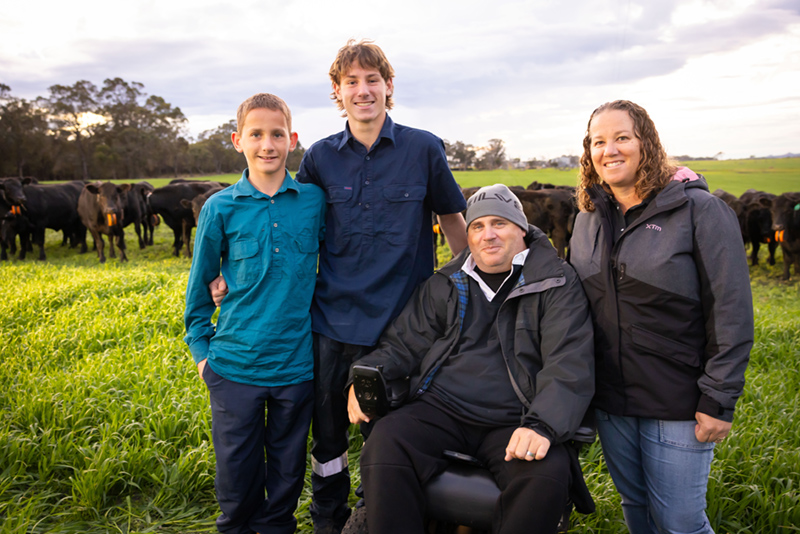 Kent and Michelle Rochester with their sons Kobi (left) and Thomas (right). Image: James Campbell for Coles Nurture Fund
Kent and Michelle Rochester with their sons Kobi (left) and Thomas (right). Image: James Campbell for Coles Nurture Fund
Breaking down barriers to success
Innovative WA beef producers Kent and Michelle Rochester are reaping the rewards of embracing ag-tech and thinking outside the box as they manage their thriving grassfed cattle finishing operation.
The multigenerational family farm on WA’s south coast was settled by Kent’s grandfather in 1956. It was planted out to blue gums in the 1990s. When Kent and Michelle bought the farm in 2005 they began transforming the plantation into a highly efficient grazing enterprise where they finish up to 3,000 yearling and heavy weaners year-round.
Adapting to change
While working in a vineyard when he was 21, Kent acquired a life-changing spinal injury, resulting in paraplegia. Although a significant setback for a young man just starting out in his career, his focus remained fixed on forging a future in agriculture. Kent’s resilience and adaptability, along with the support of his family, has seen him push the boundaries both personally and within his business.
“Being in a chair has changed the way I farm, but I think there’s some real positives that have come out of it,” Kent said.
“I have time to think about things and analyse what’s going on and make things happen that other people don’t have time to sit back and see from the outside. I think that’s a bonus.”
Day-to-day, Kent conducts much of his work out in the paddocks in his converted ute and tractors. He also makes use of a range of ag-tech to keep on top of his cattle’s daily gain and pasture utilisation.
“I live in my ute. I set it up a few years ago – I spent about a month just daydreaming how on earth I was going to make a dual-cab ute work,” Kent said.
“I’ve done more than a million kilometres and I guess 10,000 hours in tractors and different machines and figuring some of that out took some doing.
“We built sling-type lifts to sling me into several loaders and tractors – the first few were a bit dodgy but now we have a really good set-up. We also have a few different seat lifts to transfer me from wheelchair height to 4WD seat height to allow me to access my mobile office.”
Going green opens new markets
Following a particularly tough autumn in 2018, Kent and Michelle made a conscious choice to move further towards a regenerative farming approach.
They now supply the Coles Graze grassfed beef program and online regenerative farmers market company, Dirty Clean Food.
Switching from a breeding to a finishing operation worked in well with this shift.
“We moved over from breeding to grass finishing, mainly because I’m on this quest to be really efficient with our grass and gaining as many kilos of beef as we can from what we’ve got,” Kent said.
Currently they are sitting at about 600kg beef/ha/year but Kent wants to keep pushing the boundaries.
“Profitability is a driver of getting more kilos of beef per hectare. It’s pretty tough and the margins are really tight,” Kent said.
Virtual fencing fast-tracks gains
Implementing an intensive rotational grazing system was the next logical step to boost their pasture utilisation efficiency, and their 2024 investment in virtual fencing gave them the flexibility to fully realise the system’s potential.
“Fencing plans, water plans, grazing plans were all on the table. There was no preset paddock plan or anything like that. That’s what first got me looking into virtual fencing,” Kent said.
“We changed everything up and the farm hasn’t looked back since. We’ve gone to super-frequent shifts of grazing per paddock, kept a careful eye on how much pasture is left after each shift and moved to super high density.”
He and Michelle gained further grazing management skills by attending a Grazing Matcher™ Profitable Grazing Systems (PGS) training course – designed to improve the productivity, profitability and resilience of producers by enabling them to better match grazing pressure, fertiliser application, animal requirements and market demands.

The Rochesters’ cattle have quickly learned where the virtual fence boundaries are thanks to their solar-powered collars. Image: James Campbell for Coles Nurture Fund
A moveable feast
The couple initially invested in 50 virtual fencing collars and currently manage 500 cattle with the technology. Their next target is 1,200 collars – to be achieved with the help of a Coles Nurture Fund grant – and Kent’s goal is to implement a virtual fence line that moves continually across the property, elegantly guided by information fed back to him in real-time.
“Once the cattle are trained to the fence, you can make a lot of changes,” Kent said.
“I can’t wait for the point where we can move over to a rolling fence that moves two to three metres an hour and literally rolls down the paddock.”
The fencing technology also allows Kent to manually redraw fence lines and set up movements according to a pre-programmed schedule. Leaving enough space around water points and getting used to fences which he can’t physically see has been important.
“The only constraint we’ve encountered so far is that it can take a bit of time for the signal to get to the collar and change the animal’s coordinates,” Kent said.
How the collars work
The solar-powered collars use GPS to monitor cattle’s movements and emit beeps when they approach the virtual fence line. If they continue past it, an electrical pulse is administered.
“They turn around and realise where the boundary is. At first, we were worried about the welfare side of things, especially my wife. I thought I’d be looking at how adverse their reaction to it would be, but instead, we found a positive reaction,” Kent said.
“Seeing cattle that are gaining 2.5kg/day on grass and walking up to you and licking the ute’s mirrors and looking really relaxed and really happy, reassured us that they were doing way better than I ever imagined.”
Return on investment
In the long term, Kent and Michelle hope to set up most of their farm with virtual fencing, but at $350 per collar, they’re keen to make sure there’s a healthy return on investment.
“We saw amazing results with our first 50 collars, even in the first month. Although we had a really short growing season in 2024, we had a period where we were growing a lot of beef,” Kent said.
Labour and infrastructure savings, along with the increase in productivity and grazing efficiency, are good reasons to keep going.
“I would like to think they’ll be paid for in three or four years. I might be being a bit optimistic, but it’s looking really good so far.”
Tech working in tandem
Virtual fencing is just one part of a suite of ag-tech Kent uses at his property – and making sure it’s all in sync has been the key to his success.
“The feedback on how often we’re moving the cattle and what that’s doing to them in real time in terms of weight gain is the main driver of our great results,” he said.
“We know that if we move them, leave them but then keep them there too long, they’re going to pull back in weight gain. If we move them too fast, we’re wasting grass.
“Maximising what we can get out of that paddock and turning it into beef depends on meshing all those parts together.”
Kent uses Optiweigh, a system to measure animal weights in real time, direct from the paddock, for ground-truthing the feeding of pasture and the rations they develop for supplementary feeding.
“It tells us whether they’re gaining weight or losing weight and helps us understand what is happening in a paddock.
“Right now, I’m looking at the feed we’re giving a particular mob and it’s not working. They’ve flatlined on their weight gain so we’ll change up their feed straight away,” he said.
“We don’t have to wait a month until they come back to the yards and then realise that we’ve missed a month of weight gain. It means we can act on things much faster.”
Kent uses a grazing management app where he can log feeds, keep an eye on cost of production and tailor rations to achieve his target weights. This is particularly useful in an operation like Kent’s that supplies beef every week to specific markets with set parameters around carcase weights.
Electronic identification (eID) tags help keep track of animals, particularly of their bloodlines.
“We get information on how we’re doing and how they are performing. It informs our decisions around whether we should buy those bloodlines again and how they are going to grade in terms of eating quality.”
|
Kent’s farm was featured as a virtual farm tour at an MLA MeatUp forum in Wagga Wagga. View the tour below. |
Note: Use of virtual fencing is governed by relevant state authorities and is currently restricted in some jurisdictions. Find out what legislation is relevant to your state here.



